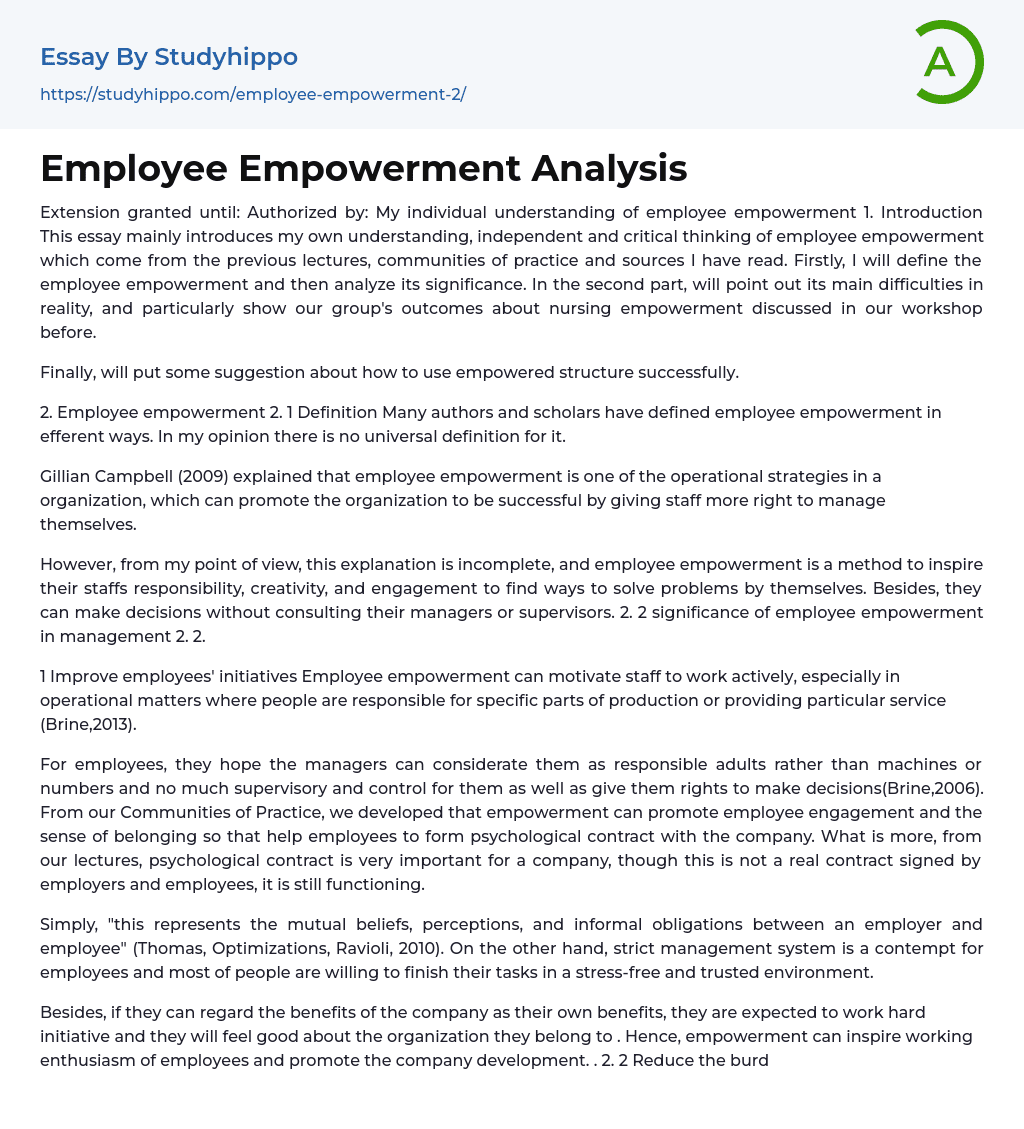In this essay, I will discuss employee empowerment, drawing on previous lectures, communities of practice, and sources that I have read. Employee empowerment is an operational strategy in organizations that gives staff more power to manage themselves and find solutions to problems independently. Although there is no universal definition for it, many authors and scholars define it differently. According to Gillian Campbell (2009), employee empowerment promotes success by giving staff more power. However, in my opinion, her explanation is incomplete as employee empowerment also inspires responsibility, creativity and engagement among employees while allowing them to make decisions without consulting their managers or supervisors.
Employee empowerment has significant benefits for management including increased trust between employees and management leading to higher job satisfaction levels and motivation which ultimately results in higher productivity rates as well as improved organizational performance. This paper will also identify the main diffic
...ulties associated with implementing an empowered structure successfully before exploring our group's findings about nursing empowerment from a previous workshop. Finally, suggestions for how empowered structures can be implemented successfully will also be proposed.Employee empowerment can enable individuals to take ownership of their work and identify opportunities for improvement. However, obstacles such as resistance from management or employees, insufficient policy support, and undefined objectives may make successful implementation challenging. To effectively implement employee empowerment, it is essential to understand its significance in management and anticipate potential challenges. Management should provide the necessary structures and support to encourage independent problem-solving among employees, resulting in increased job satisfaction, productivity, and organizational success. Empowering workers creates a sense of responsibility and encourages participation in operational tasks by assigning specific roles while minimizing supervision and
control. Through our Communities of Practice discussions, we have found that empowering employees promotes engagement and fosters a sense of belonging that helps establish a psychological contract between employers and workers – crucial for mutual beliefs, perceptions, informal obligations towards each other’s success (Thomas et al., 2010).On the one hand, strict management systems may cause employees to feel contemptuous and dissatisfied. On the other hand, creating a trustworthy and stress-free work environment that makes employees feel like they are working for their own benefit can fuel their enthusiasm and boost overall company growth. This is why employee empowerment is considered a source of inspiration for initiative and enhances working efficiency (Brine, 2013).
To promote employee growth, traditional management systems need to be streamlined so that staff members are given decision-making authority rather than needing to report everything back to managers for guidance or directives. After discussions in workshops, it was concluded that this approach is time-consuming and often unnecessary. Empowering employees involves giving up some control, which enables managers to adopt a strategic approach while also reducing costs.
Our ideal work environment would prioritize empowerment over hierarchy by encouraging everyone within the organization to take personal responsibility when problem-solving. Although this approach can present challenges initially, it fosters creativity while making us more competitive and improving our decision-making ability - ultimately leading to an improved organization overall.
Despite its potential advantages for an organization's development, implementing employee empowerment may prove challenging at times.Although initially seen as a solution to organizational issues such as low productivity and job satisfaction, creating a non-hierarchical workplace may not be the answer. These perspectives fail to recognize the complexities involved in employee empowerment,
which has been met with apprehension from both managers and employees. Some companies even view empowerment as problematic due to reasons such as unrealistic or unsuitable expectations from employees, feelings of distrust and frustration, difficulty adjusting to an empowered workplace for those accustomed to traditional hierarchy, executive managers being hesitant to take on additional responsibilities, and inadequate training resulting in incompetence among workers.
- Career Choice essays
- Career Goals essays
- Career Plan essays
- Community Service essays
- Dream Job essays
- Duty essays
- Employee essays
- Internship essays
- Interview essays
- Job essays
- Job Interview essays
- Performance Appraisal essays
- Portfolio essays
- Service essays
- Skills essays
- Vocation essays
- Work Experience essays
- Work-Life Balance essays
- American Dream essays
- Barriers To Entry essays
- Capitalism essays
- Central Bank essays
- Compensation essays
- Consumerism essays
- Economic Development essays
- Economic Growth essays
- Economic Inequality essays
- Economic System essays
- Economy essays
- Employment essays
- Export essays
- Finance essays
- Free Trade essays
- Gross Domestic Product essays
- Human Development essays
- Income Inequality essays
- Industry essays
- Inflation essays
- International Business essays
- International Trade essays
- Macroeconomics essays
- Materialism essays
- Max Weber essays
- Microeconomics essays
- Minimum Wage essays
- Monetary Policy essays
- Monopoly essays
- Pricing essays
- Profit essays
- Recession essays




